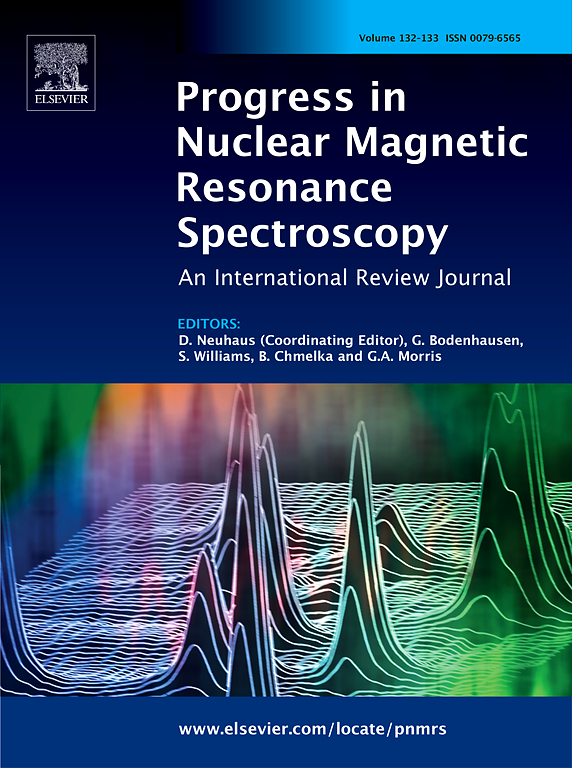Nonlinear effects in magnetic resonance localized spectroscopy and images
IF 7.3
2区 化学
Q2 CHEMISTRY, PHYSICAL
Progress in Nuclear Magnetic Resonance Spectroscopy
Pub Date : 2025-01-17
DOI:10.1016/j.pnmrs.2025.101557
引用次数: 0
Abstract
The nonlinear effects associated with intermolecular multiple-quantum coherences (iMQCs) that are present in magnetic resonance imaging (MRI), localized spectroscopy (MRS), and spatially resolved thermometry of biological tissues are reviewed. These nonlinear effects occur especially for samples with a high concentration of resonant nuclei, at ultra-high magnetic fields or under hyperpolarization conditions. The classical Bloch equations and approaches based on quantum mechanical density operator evolution were employed for description of nonlinear effects on the spin system response in the presence of distant (long-range) dipolar field in samples containing high molecular mobility like liquids. The multiple spin echoes that appear in the presence of dipolar demagnetization fields in the presence of homogenous and heterogenous spin interactions and their applications are also discussed. One emphasis of the review is on the excitation, evolution, and detection of intermolecular zero-quantum coherences (iZQCs) and intermolecular double-quantum coherences (iDQCs) in the presence of correlated field gradients that represent the basis for CRAZED pulse sequences (Warren et al. Science 262 (1993) 2005–2009). The physics behind these methods employed for magnetically equivalent and non-equivalent spins, J-coupled spin, in homonuclear and heteronuclear systems is discussed. The principles of magnetic resonance localized spectroscopy and imaging applications for brain investigations to reduce the effect of inhomogeneous magnetic fields and to increase the image resolution is reviewed. The physics related to the used of CRAZED methods to produce fundamentally different contrast than does conventional imaging is also addressed. Collective effects in the presence of strong nuclear magnetization that can affect MRI and MRS results such as spectral clustering and spin turbulence are summarized.

磁共振局域光谱学和图像中的非线性效应
本文综述了存在于磁共振成像(MRI)、局部光谱(MRS)和生物组织空间分辨测温中的分子间多量子相干(imqc)的非线性效应。这些非线性效应尤其发生在具有高浓度共振核的样品中,在超高磁场或超极化条件下。采用经典的布洛赫方程和基于量子力学密度算符演化的方法,描述了液体等高分子迁移率样品在远(长)偶极场作用下自旋系统响应的非线性效应。讨论了偶极退磁场存在、均相和异相自旋相互作用存在时出现的多重自旋回波及其应用。该综述的一个重点是在相关场梯度存在的情况下分子间零量子相干(izqc)和分子间双量子相干(idqc)的激发、演化和检测,这些相干场梯度代表了CRAZED脉冲序列的基础(Warren等)。科学262(1993)2005-2009)。讨论了在同核和异核系统中磁等效和非等效自旋、j耦合自旋的物理原理。综述了磁共振定位波谱的原理及其在脑成像中的应用,以减少不均匀磁场的影响,提高图像分辨率。与使用CRAZED方法产生与传统成像根本不同的对比度相关的物理问题也得到了解决。总结了强核磁化下的集体效应,如谱聚类和自旋湍流等影响MRI和MRS结果。
本文章由计算机程序翻译,如有差异,请以英文原文为准。
求助全文
约1分钟内获得全文
求助全文
来源期刊
CiteScore
14.30
自引率
8.20%
发文量
12
审稿时长
62 days
期刊介绍:
Progress in Nuclear Magnetic Resonance Spectroscopy publishes review papers describing research related to the theory and application of NMR spectroscopy. This technique is widely applied in chemistry, physics, biochemistry and materials science, and also in many areas of biology and medicine. The journal publishes review articles covering applications in all of these and in related subjects, as well as in-depth treatments of the fundamental theory of and instrumental developments in NMR spectroscopy.

 求助内容:
求助内容: 应助结果提醒方式:
应助结果提醒方式:


